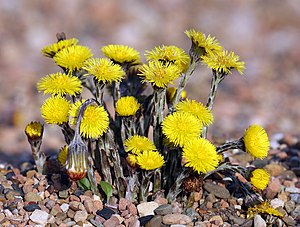Tussilago farfara: Difference between revisions
καλῶς γέ μου τὸν υἱὸν ὦ Στιλβωνίδη εὑρὼν ἀπιόντ' ἀπὸ γυμνασίου λελουμένον οὐκ ἔκυσας, οὐ προσεῖπας, οὐ προσηγάγου, οὐκ ὠρχιπέδισας, ὢν ἐμοὶ πατρικὸς φίλος → Ah! Is this well done, Stilbonides? You met my son coming from the bath after the gymnasium and you neither spoke to him, nor kissed him, nor took him with you, nor ever once felt his balls. Would anyone call you an old friend of mine?
mNo edit summary |
mNo edit summary |
||
| Line 1: | Line 1: | ||
{{lael | {{lael | ||
|lgtx=[[ἀκρόφυλλον]], [[βηκία]], [[βήκιον]], [[βηχίον]], [[βήχιον]], [[γαβαλήνα]], [[παγγόνατον]], [[πήχιον]], [[πίθιον]], [[χαμαίγειρον]], [[χαμαιλεύκη]] | |lgtx=[[ἀκρόφυλλον]], [[βηκία]], [[βήκιον]], [[βηχίον]], [[βήχιον]], [[γαβαλήνα]], [[παγγόνατον]], [[πήχιον]], [[πίθιον]], [[χαμαίγειρον]], [[χαμαιλεύκη]] | ||
}} | |||
{{wkpen | |||
|wketx=[[File:Coltsfoot.jpg|thumb|Coltsfoot]] Tussilago farfara, commonly known as coltsfoot, is a plant in the tribe Senecioneae in the family Asteraceae, native to Europe and parts of western and central Asia. The name "tussilago" is derived from the Latin tussis, meaning cough, and ago, meaning to cast or to act on. It has had uses in traditional medicine, but the discovery of toxic pyrrolizidine alkaloids in the plant has resulted in liver health concerns. | |||
Tussilago farfara is the only accepted species in the genus Tussilago, although more than two dozen other species have at one time or another been considered part of this group. Most of them are now regarded as members of other genera (Chaptalia, Chevreulia, Farfugium, Homogyne, Leibnitzia, Petasites, Senecio). | |||
}} | }} | ||
Revision as of 17:09, 15 January 2024
Latin > Greek
ἀκρόφυλλον, βηκία, βήκιον, βηχίον, βήχιον, γαβαλήνα, παγγόνατον, πήχιον, πίθιον, χαμαίγειρον, χαμαιλεύκη
Wikipedia EN
Tussilago farfara, commonly known as coltsfoot, is a plant in the tribe Senecioneae in the family Asteraceae, native to Europe and parts of western and central Asia. The name "tussilago" is derived from the Latin tussis, meaning cough, and ago, meaning to cast or to act on. It has had uses in traditional medicine, but the discovery of toxic pyrrolizidine alkaloids in the plant has resulted in liver health concerns.
Tussilago farfara is the only accepted species in the genus Tussilago, although more than two dozen other species have at one time or another been considered part of this group. Most of them are now regarded as members of other genera (Chaptalia, Chevreulia, Farfugium, Homogyne, Leibnitzia, Petasites, Senecio).

